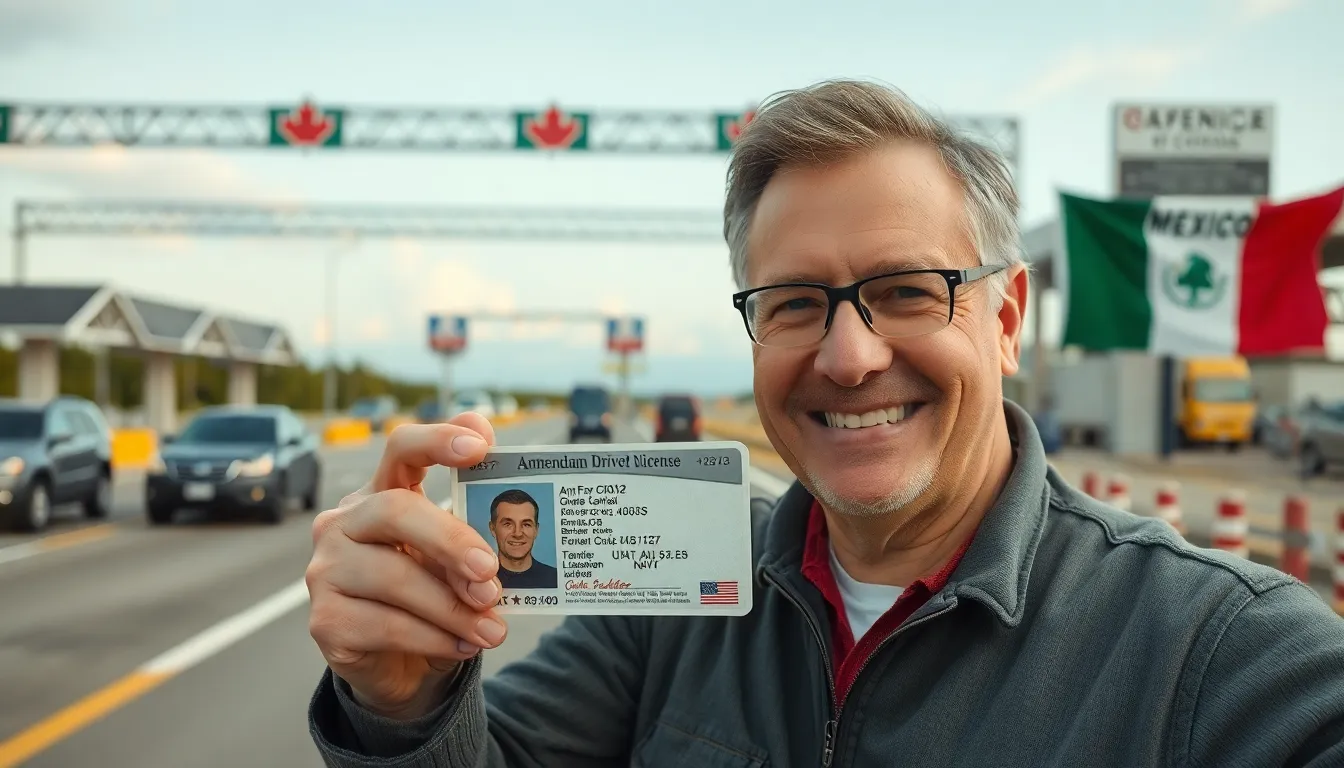Getting an enhanced driver’s license might sound like a quest for the Holy Grail, but it’s actually a lot easier than you think. Picture this: you’re cruising through the border with a smile, waving at the customs officer, and feeling like a travel pro. With an enhanced driver’s license, you can skip the hassle of a passport for certain international trips. Who knew a little piece of plastic could unlock so many adventures?
Table of Contents
ToggleWhat Is an Enhanced Driver’s License?
An enhanced driver’s license (EDL) serves as a state-issued identification card. It provides the same driving privileges as a standard driver’s license while also facilitating border crossings to Canada and Mexico. An EDL incorporates additional security features, like a radio frequency identification chip. This chip allows quick identification at border checkpoints, ensuring a streamlined process for travelers.
States issue enhanced driver’s licenses, including Michigan, Minnesota, New York, and Washington. Each state may have different application procedures, but the general eligibility requirements include being a U.S. citizen and holding a standard driver’s license. Additionally, an EDL meets federal REAL ID requirements, making it a suitable identification option for domestic air travel.
Possessing an EDL can simplify international travel. When crossing certain borders, travelers can present their EDL in place of a passport, reducing wait times and enhancing convenience. Moreover, EDLs validate identity in various situations, such as when boarding flights or accessing secure facilities.
An enhanced driver’s license provides crucial benefits, combining driving privileges with enhanced identification capabilities. This license is an excellent option for frequent travelers, offering a practical solution that saves time while traveling internationally.
Benefits of an Enhanced Driver’s License

An enhanced driver’s license (EDL) offers various advantages that enhance travel and identification.
Travel Advantages
Traveling with an EDL simplifies crossing borders into Canada and Mexico. Instead of presenting a passport, travelers can show their EDL, expediting the process at checkpoints. Obtaining an EDL saves time at border crossings, often leading to shorter wait times compared to traditional passport checks. Issuing states, like Michigan and New York, ensure that the EDL meets federal standards for identification. Additionally, this convenience makes spontaneous trips more manageable without the hassle of carrying multiple forms of identification.
Identification Benefits
An enhanced driver’s license provides secure identification, suitable for various situations. Presenting an EDL at airports for domestic flights satisfies REAL ID requirements. This license includes advanced security features, making it difficult to counterfeit. Individuals often use their EDL to verify identity for age-restricted purchases or accessing secure buildings. Holding an EDL brings peace of mind, knowing it complies with state and federal regulations, which enhances overall security while traveling or at home.
Requirements for Obtaining an Enhanced Driver’s License
Obtaining an enhanced driver’s license (EDL) involves meeting specific criteria. Applicants must fulfill age and residency requirements, along with providing necessary documentation.
Age and Residency
Applicants must be at least 18 years old to apply for an EDL. Residency in a state that issues EDLs is crucial. States like Michigan, Minnesota, New York, and Washington require proof of residency within their jurisdictions. Those under 18 can obtain a license but need parental consent and must hold a learner’s permit for a specified duration. State-specific rules can refine these requirements, so checking local regulations helps.
Documentation Needed
Necessary documentation includes proof of identity, residency, and U.S. citizenship. A standard driver’s license suffices as proof of identity, while utility bills or bank statements can demonstrate residency. Applicants also need to provide a birth certificate or valid passport for citizenship verification. Some states may require additional documents, such as Social Security cards, so verifying specific state requirements ensures a smooth application process.
The Application Process
The application for an enhanced driver’s license involves several specific steps. Knowing where to apply and the necessary actions simplifies the process significantly.
Where to Apply
Individuals can apply for an enhanced driver’s license at designated state Department of Motor Vehicles (DMV) offices. States like Michigan, Minnesota, New York, and Washington offer their unique application processes. Each state may also have online options available, increasing accessibility for applicants. Check the state DMV website to find local offices and specific instructions.
Steps to Complete Your Application
Completing the application involves several key actions. Gather required documents such as proof of identity, U.S. citizenship, and residency. Fill out the application form accurately, ensuring all information matches provided documents. Schedule an appointment at the state DMV, if necessary, to avoid long wait times. Pay any associated fees, which can vary by state, typically between $20 and $50. Once all steps are completed, submit your application and photographs as required.
Cost and Processing Time
Costs for an enhanced driver’s license vary by state, typically ranging from $20 to $50. Some states may charge additional fees depending on specific circumstances, such as the location of the DMV. Understanding the precise fee structure for the respective state simplifies budgeting.
Processing times for an EDL also fluctuate, with some states offering rapid services while others may take longer. Generally, applicants can expect a processing period of anywhere from two to six weeks. Availability of expedited processing in certain states can shorten this timeframe significantly.
Submitting the application online might lead to faster processing in states that provide this option. Heightened demand during peak travel seasons may slow down processing times, so planning ahead is crucial. Tracking application status online or through the DMV ensures applicants stay informed about their license progress.
In addition to the processing time, documentation required for an EDL can also impact the overall timeline. Gathering proof of identity, residency, and U.S. citizenship in advance streamlines the application process. Providing accurate and complete information reduces delays in processing as well.
Checking with the local DMV office for updates on specific costs and processing times guarantees that applicants have the most accurate and current information.
An enhanced driver’s license offers a practical solution for those looking to simplify their travel experiences. With its added benefits for international border crossings and compliance with REAL ID requirements, it’s an asset for frequent travelers.
By understanding the application process and requirements, individuals can easily obtain their EDL. This not only enhances convenience but also provides peace of mind with its advanced security features.
For anyone considering travel to Canada or Mexico, getting an enhanced driver’s license is a smart choice that streamlines the journey and opens up exciting opportunities for exploration.



